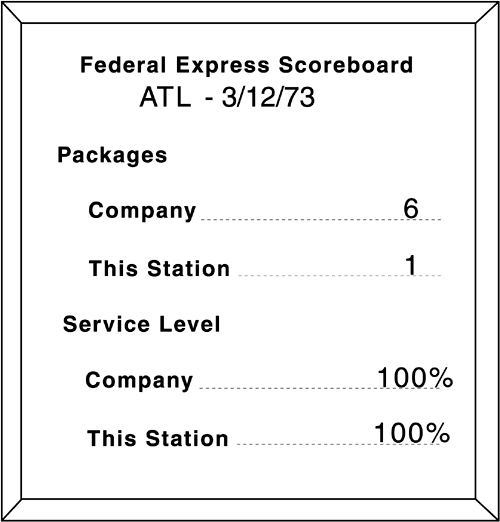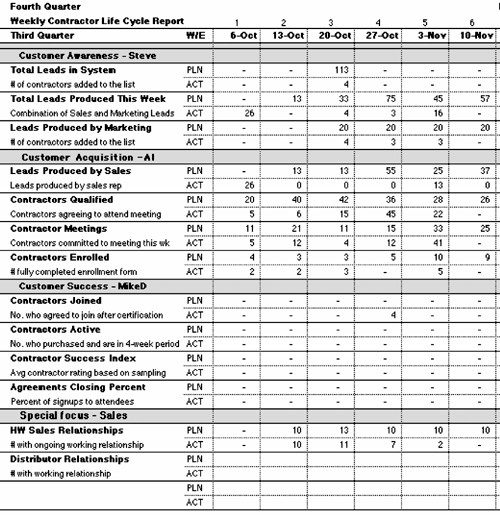I would like to say feedback is the most important of the big three ingredients for success in building cultural structures (goals, relevance, and feedback), but all three are equally important. If there are no clear and balanced goals, feedback is irrelevant. If the goals are not relevant, feedback is ignored.
Like making steel, soup, or any other compound, without all the ingredients in their proper proportion, the result is not complete.
At the beginning of Federal Express, Roger Frock, then general manager, implemented a simple, but very powerful, feedback system. Wherever there were employees, there was a whiteboard, and each morning it displayed four numbers from the previous day's activity (see Figure 7-1).
This was the board in Atlanta that first day (see Chapter 1). After the first day, there was one overwhelming vision, GET THE PACKAGES, and the feedback system was essential to getting all employees to rally around that flag.
Today, the scoreboard is more complex, but the concept is the same. Let all employees see how they are doing as a team and where practical, as individuals, to achieve the company's primary goals.
Again, it is like a football game where everyone (fans, players, and coaches) is vitally aware of the current results and change their actions according to the feedback they are receiving.
Using the football analogy, feedback is not limited to a scoreboard. Feedback from the coach is constant and often quite personal.
To see is to move. When people truly see the nature of what is compared to what they desire, they will move to correct the situation in ways that are unknown to senior managers. There are examples given in Chapter 1 such as a Federal Express driver who “stole” packages from competitors, a woman who chartered an airplane, or a driver who left his watch with a service station attendant to purchase enough fuel to complete his deliveries.
These examples and thousands more illustrate the actions people will take when there are vision and values, the goals are clear and relevant, and the feedback is simple and consistent.
If my job is to pick up packages, provide great service on the phone, or fly the airplane, it doesn't matter as long as the cultural structure is in place and driven by leadership.
Both Federal Express and UPS use a weekly add-a-line report for weekly feedback. This is a tool that can be used in nearly every industry and is a highly effective weekly scoreboard. Figure 7-2 shows an example of a growth report.
This is a simple spreadsheet laid out for a quarter. The actual sheet shows 13 weeks and has total, percent of quarter, and goal columns. For example, if the quarter is three weeks old (24% of 13 weeks) and the actual is at 24%, the goals are being met for the quarter.
This particular add-a-line report is focused on growth for a small start-up company's growth team (see the concentric organization in Chapter 12) representing marketing (Customer Awareness), Sales (Customer Acquisition), and Service (Customer Success). Each of these categories of activities represents a segment in the customer life cycle.
There are several things to note with this feedback system.
First, there are only a few critical elements in each of the categories: that the goals of the customer (Customer Success Index) and the goals of the owners (Contractors Enrolled) are shown and monitored weekly.
Employee goals are also included because commissions and bonuses are paid by meeting the goals shown. As the company grows, employee goals will become more specific.
Second, the system is weekly and quarterly, not monthly. At Federal Express, like many companies today, fiscal months are used with months being 4 weeks, 4 weeks, and 5 weeks (or 5, 4, 4), making up a 13-week quarter.
Weeks and quarters are used for a number of reasons.
First of all, weeks are consistent and habitual. Nearly every week is the same, whereas months end on different days, have a differing number of days, and so forth.
Generally, there are meetings weekly where feedback can be used to drive discussion (additional feedback). There are always weekends, and generally people do certain things on certain days. The more habitual a cultural structure is means the more power it has for relating cause to effect.
Second, quarters make a good planning point. At the end of each quarter, people can take a slightly longer view and plan for the next quarter.
Third, the purpose of feedback in this report and all management reporting is to motivate people to act if the goals are not being met or to continue to do what is working if the goals are being met.
Monthly is simply too late to take responsible actions (response-able). If there is too much time between action and result, it breaks the cause-effect relationship and therefore doesn't drive appropriate and timely actions. The actions and the corresponding results don't relate to each other and therefore don't motivate people to act in productive ways.
For example, if I launch a new method of contacting customers this week and don't see the results for 45 days, I will not relate my action this week to results reported in the distant future. On the other hand, if I take action this week and see the results immediately, I am likely to continue the action if it worked and do something else if it didn't.
Of course, there are actions that take weeks and sometimes months to show results, and those results show up on this report as well in terms of expectations.
The point is that feedback needs to be as related to the actions as soon as possible within limits.
The fourth point to make is that, for every success indicator, there is a Plan (PLN) and Actual (ACT) indicator. The idea is to have each person set their goals for each of the indicators they are responsible for and to have them roll up into the company goals.
The best method of doing this is to set the corporate goal first and then work with the team to have its goals match or exceed the corporate goal. In the example shown in Figure 7-2, the corporate goal is five new sales per week with four salespeople. Each person thinks through his or her quarter and sets his or her plan for each indicator. If they don't add up to five, the manager works with them until a reasonable plan is developed.
At Federal Express, this weekly add-a-line report actually became a weekly profit-and-loss report and was balanced every month against the fiscal month's profit-and-loss report done primarily for accounting purposes. The company got quite good at providing a reasonably accurate weekly profit-and-loss statement given certain monthly and semimonthly charges that had to be allocated to a weekly reporting system (utilities, rent, payroll, and so forth).
In the beginning there were three primary indicators of success: package count, service level, and weeks-to-breakeven (WTB). WTB was primarily used by the executive committee to determine if the company was on track for its initial goal of profitability and therefore sustainability.
WTB was calculated each week by taking a simple least-squares distribution and projecting it out statistically to a future breakeven point. In the beginning, at Federal Express, breakeven was more than 100 weeks off, but it kept coming down. This type of indictor is especially beneficial for a start-up because it gives people a light at the end of the tunnel for the struggle that nearly all start-ups go through.
It also tells management when it needs to do something different.
If, for example, based on last week's results, the number of WTB was not at least one week less than last week, the company was falling behind. If the WTB was less than expected, management needed to evaluate what was happening and do more of whatever caused the decrease.
Like any feedback system, the daily and weekly indicators must be given relevance. This starts by making every employee aware of the key company goals, making those goals relevant, and then providing daily and weekly feedback.
After those systems are in place, what really gets and keeps people focused on the goals are management inquiries. If managers pay no attention to the feedback, no one else will either.
In the example used at UPS in Chapter 2, managers began asking questions, and people got really focused on lowering the cost per package. This was not because the goals were not clear or because of lack of feedback, but because management made the feedback and the goals relevant by asking questions.
Implementing good feedback systems is always a struggle. Most managers have their own style and their own timing. A manager who grew up in a monthly system will have difficulty moving to a weekly orientation. Managers who grew up with little or no attention paid to customer and employee goals will have a difficult time balancing their focus on owner goals to include customers and employees.
I am currently going through this, as I am implementing the cultural structure in a start-up situation with managers from varying previous experiences.
The most effective way of converting to a weekly system is to have scheduled weekly meetings, whether by conference call or face to face. During these meetings, the weekly operations report (add-a-line) becomes the primary focus of the meeting.
Because my current company is a virtual company with most of the growth team members scattered throughout the country, we conduct our meeting by conference call each Monday.
We use an agenda meeting style with a facilitator who does not make judgments, but runs the process of the meeting. The meeting has a time limit of one hour, which is strictly adhered to with some exceptions.
The facilitator starts the meeting by collecting agenda items from each participant along with the time that person feels they need to ask, give, or discuss. The one agenda item that is covered first is last week's results from the weekly operating report.
We use WebEx (a technology that enables the facilitator to show information on everyone's screen). Each salesperson states his or her numbers for the previous week, and the facilitator enters the numbers into the report. After each person has gone, management reviews the total and discusses actions needed.
Then, the meeting goes to other agenda items that are brought up at the beginning of the meeting.
This is a highly effective weekly feedback system that consists of the numeric indicators along with free and open discussion.
In the UPS example and later at Federal Express, I conducted these calls daily and weekly because both companies are in the daily business of pickup and delivery, which is mainly a daily business.
For most companies, a weekly system stubbornly adhered to works best for continual and ongoing feedback.
In the beginning of the Clinton administration, the Clintons had a great vision of affordable healthcare for everyone.
They did not take a systemic or cultural structure approach to the problem, and therefore little was accomplished. They tried to understand the problem, find its solution, and pass a government mandate to implement the solution. This is typical of most businesses when confronted with a need to move to a new vision or to make a major change in direction.
The company leader states the vision or goal and then attempts to dictate a plan to achieve the vision or to meet the goal.
In the early 1970s, another federal administration had a similar change in vision. The energy crisis and pollution scare hit simultaneously, and the government had to do something about both issues. Instead of taking the Clinton healthcare approach, it simply established the vision and laid out the goals, made them relevant, and mandated feedback.
For example, “By 1995, cars with more than X pollutants will not be sold in America. Beginning immediately, miles per gallon standards will be established for each model automobile and posted on the new car's window.”
These kinds of government policy mandates stimulate the related industries to take massive and productive actions. We are far more fuel efficient and less polluting today than we were 40 years ago because the federal government understood and applied the cultural structures approach.
In contrast, the Clinton administration sought to implement a solution rather than to mandate a result, making it relevant and providing or demanding feedback.
If we look at the systemic issues behind the healthcare system, the primary culprit is lack of direct feedback between the provider and the patient. This is primarily caused by a third-party payer system. The patient receives the services and has the provider (physician, hospital, and so forth) turn in the bill, and it is paid by a third party.
If there is poor service rendered or a mistake made in billing, it is irrelevant to the provider because there is no direct feedback from the patient.
I'll provide a couple of examples.
A close friend, an independent business woman, was pregnant. She had decided not to buy insurance coverage on herself, but did cover the baby's delivery because there can be very expensive problems at childbirth.
The baby was born prematurely and a bill for over $20,000 was paid by the insurance company without challenge by either my friend or the insurance company. On the other hand, my friend had a $1,500 bill that was challenged in several ways.
The hospital had charged her for a milk pump. Because she already had one for her previous child, she refused to take it. The hospital tried to charge her for a milking consultant. She had never seen the consultant, so she turned it down. By the time she was done, she paid only half of what the original bill invoiced.
Federal Express, realizing this phenomenon, provides a 40% rebate for all incorrectly charged medical expenses that their employees find on their medical statements. This simple incentive provides direct feedback to the provider from the patient and reduces the overall cost of medical services to Federal Express.
I remember, as a child, riding with my grandmother, who was a doctor making house calls. She had an excellent and very functional relationship with her patients. The feedback system worked very well. This was just after the Depression, and many people couldn't pay immediately or paid in trade. At any rate, the cost of medical care was far less, primarily because the feedback system was operational.
Back to Clinton's vision. Had the administration specified the goals to the three primary institutional players (providers, employers, and insurance companies) and set up the feedback systems, the industry could have or still can resolve the escalating costs of healthcare. I don't mean to oversimplify, but a well-thought-out systems approach demanding solutions from the industry will work.
By attempting to tell the healthcare industry how to solve its problem, the administration ran into unconquerable resistance, which was what happened under the Clinton plan.
More specifically, government might mandate the cost per patient with a time to reach that goal and a relevance factor that would severely penalize the industry. I realize that healthcare cost is a very complex issue and there are no simple solutions, but one thing is certain. The problems in the industry cannot be solved by government.
The people who must solve these kinds of problems are the players themselves, but they must be given the goals, made relevant with feedback to have the necessary determination to solve them together. The only real issue is that the three major players must be made to work together to resolve the issue.
Organizations make the same mistake of mandating actions rather than making goals clear and relevant and providing feedback. CustomerCulture companies then let the players take the necessary actions to resolve the issues.
Similar to relevance, feedback can and must take many forms.
Paddi Lund's feedback system involved daily staff meetings where revenue, customer passion, and employee happiness were reviewed. People then provided feedback to each other during the meeting. During the daily routine, the courtesy system was used, which provided minute-by-minute feedback between all team members.
Objective feedback can be built into the culture with good technology and discipline. Subjective feedback coming from the coach or manager and from peers is more difficult. I find daily meetings using the courtesy system to be a good method.
Our team meets by phone every day, and each person rates themselves on a two-dimensional (2D) scale:
Productivity on a scale of 1 to 5
Happiness on a scale of 1 to 5
As long as I am objective, this feedback system uncovers any hidden agendas and puts all the cards on the table for both the manager and the employees.
Summarizing, feedback systems are essential to building high-performing cultural structures, and they cover the objectively measurable along with the subjective judgments of a well-disciplined coach, who provides feedback as close to the point of action in time as possible.


